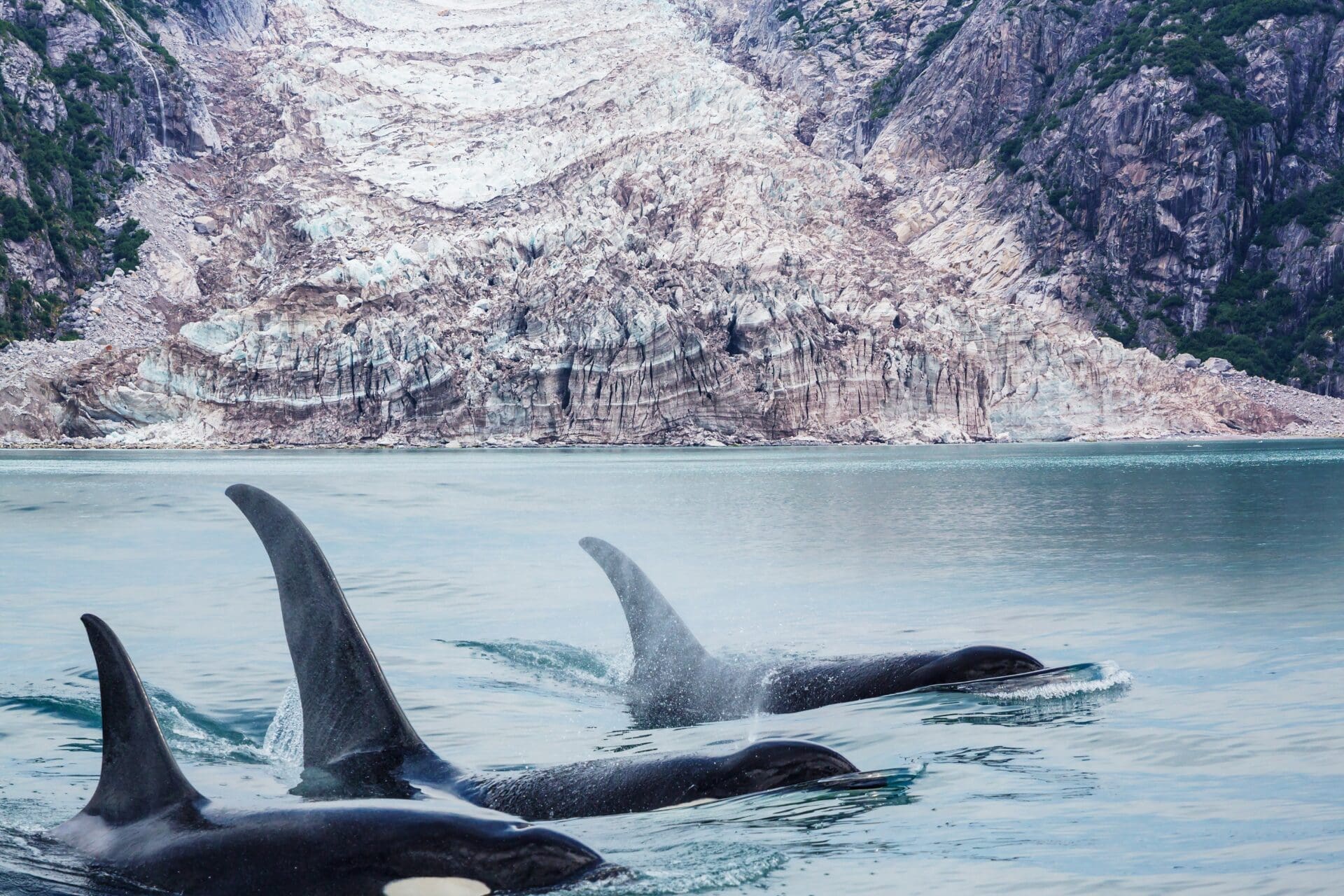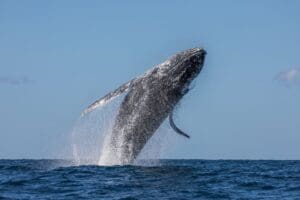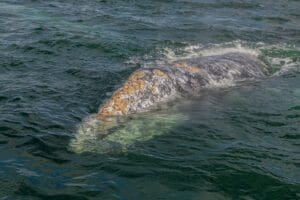Whale Behavior and Communication: A Deep Dive
Hey there, marine enthusiast! Ever wondered what’s happening beneath the waves with the ocean’s most majestic inhabitants? Join us as we venture into the underwater realm to unveil the social giants of the sea—whales. These leviathans are not just about sheer size; they’ve got complex social lives and communication skills that rival any land mammal. In this deep dive, we’ll explore every flipper and fin of whale behavior, from the intricate songs emitted by their not-so-vocal ‘vocal cords’ to the thunderous tail slaps that resonate through the deep blue. So strap on your diving gear, and let’s plunge into the unseen world of whale behavior and communication.
Understanding Whale Communication Methods
Let’s dive deeper into the aquatic chatterbox lifestyle of whales. Much like us, these ocean giants have plenty to say, and they’ve got some pretty cool ways to say it. We’re not just talking about your average vocal calls—whales use a whole repertoire of sounds and signs to chat with each other. Imagine sending messages across miles of ocean. Pretty impressive, right?
Exploring the vocalizations of the ocean’s largest inhabitants
Whales are like the A-list celebrities when it comes to oceanic vocals. They use a variety of vocalizations to communicate, from the haunting songs of the humpback whales that can continue for hours, to the quick, click-based language of orcas. These sounds serve many purposes, including mating calls, warnings, and keeping track of each other in the murky deep.
Non-vocal signs of expression in the marine context
But it’s not all about the whale karaoke; they’ve got body language down to a fine art. Tail slapping, breaching, and pectoral fin waves are all part of their non-vocal communication toolkit. It’s like whale morse code, sending out messages such as “back off!” or “hey, food’s this way!” without making a single sound. They also use this behavior to maintain social connections within their group, which is just as important under the waves as it is above them.
- Songs: Used primarily by males during mating season to woo their counterparts or mark their territory.
- Clicks: A sonar system for toothed whales, echolocating their way through the dark seas and hunting down snacks.
- Whistles: These are the social media DMs of the whale world, often used to communicate with pod members over short distances.
In essence, understanding whale communication methods gives us a snapshot into the complexity and richness of their underwater societies. There’s a whole world of whale dialogue waiting to be deciphered, offering insights that could ultimately help us protect these majestic creatures and the oceans they call home.
Breaching
Breaching is perhaps the most iconic of all whale behaviors and involves the whale leaping out of the water and crashing back down with a tremendous splash. Although the exact reasons for breaching are not fully understood, it is believed to be a form of communication, a way of attracting a mate, or a means of removing parasites from the skin. Whatever the reason, it is a truly awe-inspiring sight to behold.
Tail Slap and Tail Throw
Tail slap and tail throw are two behaviors that involve the whale slapping its tail against the water’s surface. Tail slap involves the whale lifting its tail out of the water and slapping it back down, while tail throw involves the whale lifting its tail and throwing it forward. These behaviors are thought to be a way of communicating with other whales or a means of stunning prey.
Pec Slap and Chin Slap
Pec slap and chin slap are two less common behaviors that involve the whale slapping its pectoral fins or chin against the water’s surface. These behaviors are thought to be a way of communicating with other whales or a means of stunning prey.
Spyhopping
Spyhopping is when the whale raises its head out of the water and looks around. It is believed to be a means of getting a better view of the surrounding environment or a way of communicating with other whales.
Blowing
Blowing is the act of the whale exhaling air through its blowhole, creating a distinctive spout of water and air. This behavior is used to clear the whale’s lungs of carbon dioxide and to take in fresh air. It is also used as a means of communication, with different patterns of blowing indicating different messages.
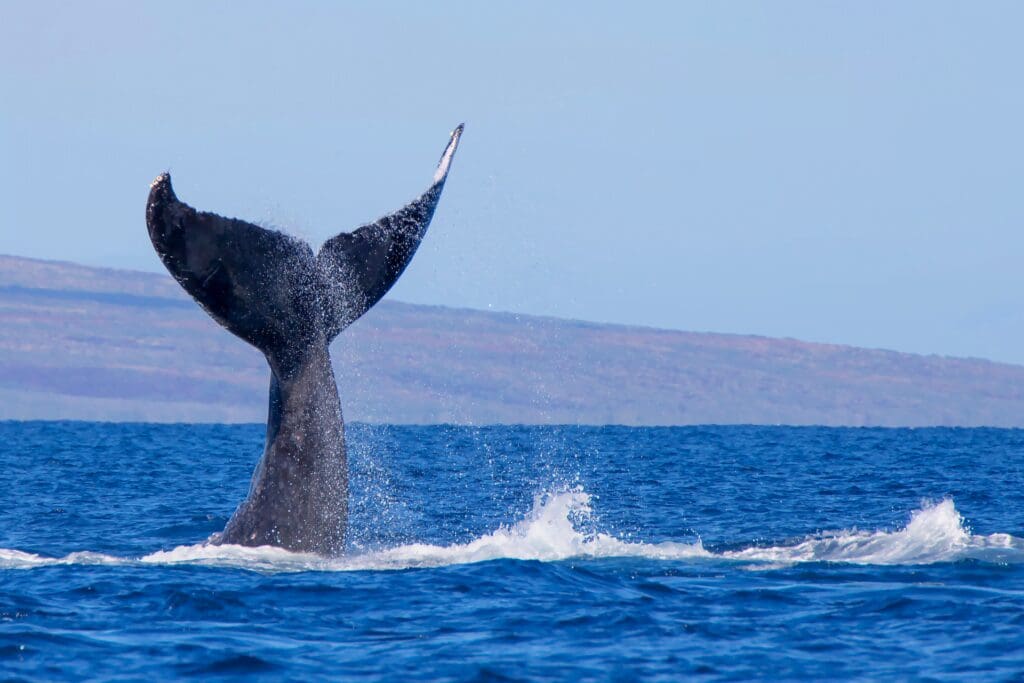
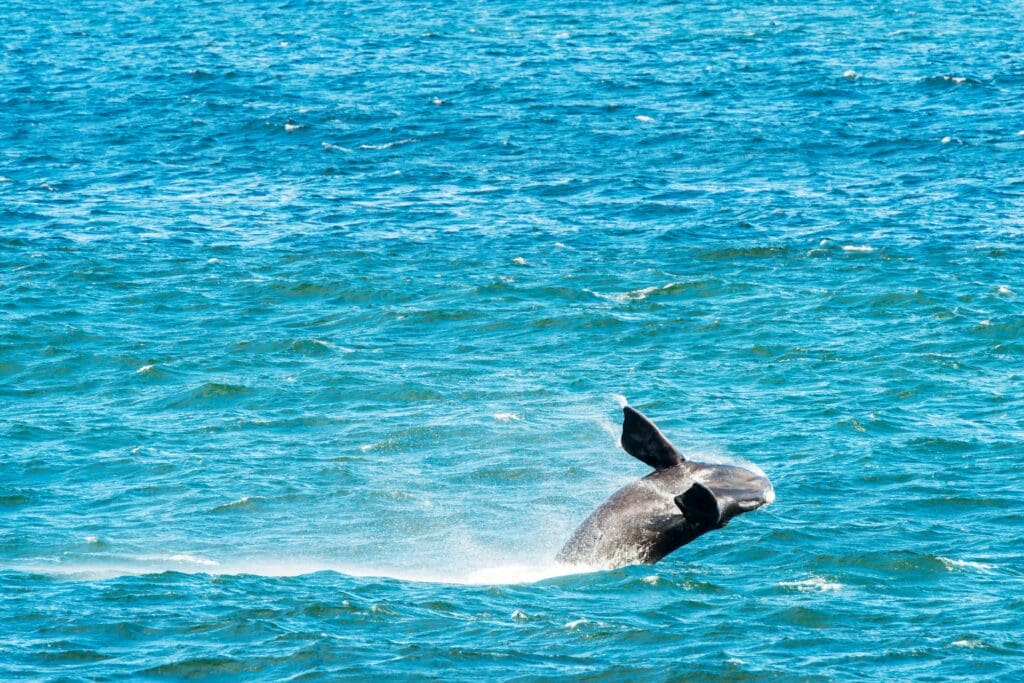
Dive Behaviors and Movements
Whales are known for their impressive diving abilities, and humpback whales are no exception. Understanding their dive behaviors and movements can provide insight into their feeding habits and migratory patterns.
Diving and High/Low Fluking Dive
Humpback whales can dive to great depths, sometimes reaching over 600 feet (183 meters) below the surface. They typically perform two types of dives: high fluking dives and low fluking dives. High fluking dives are characterized by a steep descent, with the whale arching its back and lifting its flukes high in the air before diving. Low fluking dives, on the other hand, are more gradual and less dramatic. The whale simply lowers its flukes and disappears beneath the surface. These different types of dives may indicate different feeding strategies or prey types.
Rounding Out and Logging
After a dive, humpback whales will often “round out” at the surface. This behavior involves the whale slowly rolling onto its side and exposing its ventral surface to the air. This may help the whale recover from the dive and regulate its body temperature. Another post-dive behavior is “logging,” where the whale simply floats stationary at the surface. This behavior may also help the whale recover from the dive and conserve energy.
Lunge Feeding and Kickfeeding
Humpback whales are known for their lunge-feeding behavior, which involves lunging forward with their mouths open to engulf large amounts of prey. This behavior is often accompanied by a loud exhalation or “whale blow.” Another feeding behavior is “kickfeeding,” where the whale uses its flippers to create a current that funnels prey toward its mouth. These feeding behaviors may be observed during the whales’ migration to their feeding grounds in colder waters.
Snaking
One lesser-known movement of humpback whales is “snaking,” where the whale swims in a zigzag pattern just below the surface. This behavior may be related to feeding or social interactions, but its exact purpose is poorly understood.
The Complex Social Structures of Whales
Dive into the fascinating world of whales, and you’ll uncover a complex web of relationships and social hierarchies that rival our own. Whales are not just massive creatures roaming the oceans; they’re intelligent mammals with intricate ways of living and interacting with one another.
Deciphering the Whale’s Social Network
Every pod of whales, much like human social groups, has its own dynamics and associations. These networks are essential for their survival, providing a framework for everything from hunting to nurturing their young. Researchers observe the interactions within these social networks to better understand how information is passed along and how bonds are formed and maintained within the pod.
Species-Specific Social Hierarchies and Their Significance
While some whale species are known to be extremely social, forming long-lasting relationships, others may only interact for the purposes of mating or foraging. The hierarchical structure within pods can tell us a lot about the complexity of their social lives:
- Orcas follow a matriarchal structure wherein elder females lead the pod and pass on knowledge through generations.
- Humpback whales exhibit looser social ties, with associations changing from year to year, except for mother-calf bonds.
- Sperm whales have clans that exhibit shared vocalizations, indicating a complex social network.
Understanding these hierarchies is key to comprehending how whales interact, bond, and even grieve, highlighting the profound intelligence and emotional depth of these oceanic giants.
Vocalization Patterns in Cetaceans: The Language of the Seas
The deep blue sea is a veritable concert hall, where marine orchestrates like whales produce a spectacular symphony. Cetaceans, which include whales, dolphins, and porpoises, are renowned for their complex vocalization patterns. These vocal expressions are not just mere sounds but are crucial for survival, navigation, and social interaction within the aquatic depths.
The Language of the Seas: Analyzing Patterns and Meanings
Cetaceans employ a rich tapestry of clicks, whistles, and pulsed calls that often vary in pitch, duration, and frequency. Researchers decode these vocalizations to understand the context and purpose behind each conversation. Whether it’s a pod of dolphins engaged in a communal hunt or a solitary whale navigating through vast oceans, each vocal pattern serves a specific function. This acoustic communication is vital for maintaining social networks, coordinating group behaviors, and for the passage of knowledge across generations.
How Species and Context Dictate Whale Calls
It’s fascinating to note that not all whales ‘speak’ the same language. For instance, killer whales have dialects unique to their pods, while the majestic songs of the humpback whales are signature to their species. The context of communication also plays a significant role, where the same sequence of sounds can mean different things depending on the situation. A distress call during a predator threat varies significantly from a social call amidst peaceful foraging.
- Social Bindings: Vocalizations are a glue that cements relationships within a community, playing a pivotal role in the social structure of cetacean pods.
- Echoes of Navigation: Beyond socialization, these vocal cues assist whales in navigating the murky oceanic waters, where visibility is limited.
- The Rhythm of Reproduction: During mating seasons, vocalizations turn into elaborate serenades that play a key role in courtship rituals.
Delving into the acoustic world of whales offers us a glimpse of an elaborate communication system. As we further unravel the mysteries of vocalization patterns in cetaceans, we come closer to understanding the enigmatic language of the seas—a language that continues to capture our imagination and fuels our passion for marine science.
The Use of Echolocation in Toothed Whales
Dive deep into the oceanic world of toothed whales and you’ll discover one of nature’s most fascinating biological adaptations: echolocation. Unlike their baleen counterparts, these marine mammals possess an extraordinary ability to navigate and hunt using sound. It’s a bit like having a built-in sonar system that provides an acoustic blueprint of their surroundings, allowing them to “see” with sound in the darkest depths of the sea.
Biologic Sonar Systems: How Whales ‘See’ with Sound
Think of echolocation as a sound-shaped flashlight illuminating the unseen for toothed whales. When a whale echolocates, it emits a series of clicks that travel through the water until they hit an object, then bounce back as echoes. The whale’s sophisticated auditory system picks up these echoes, interpreting them to understand the size, shape, distance, and even the speed of objects around them. Strong muscles in the melon (the fatty tissue on their forehead) can focus these clicks into a narrow beam, honing in on their target with impressive precision.
Echolocation and its Role in Prey Capture
When it’s time for dinner, echolocation becomes a toothed whale’s best friend. Under the cloak of the ocean, these whales emit high-frequency sound waves that zero in on potential prey. The rapid succession of clicks creates a detailed sonic image of the prey, enabling the predator to track, chase, and ultimately capture it. This is not just about finding a meal; echolocation is vital for the survival of these ocean giants, as the pitch-perfect sound waves help them navigate the murky and often obstacle-laden waters they call home.
- How powerful is a whale’s echolocation? – It’s so effective that toothed whales can detect a fish as small as a golf ball over 100 meters away!
- Can the prey sense these clicks? – Most of the time, prey species cannot detect the high-frequency sounds, which gives the whale the element of surprise.
- Is echolocation shared amongst all whales? – No, it’s a special feature of toothed whales. Baleen whales, such as humpbacks and blue whales, do not use echolocation.
As we resurface from this auditory adventure, it’s clear that the use of echolocation in toothed whales is a remarkable adaptation that has evolved over millions of years. By navigating the vast and variable ocean landscape, they showcase the incredible complexity and diversity of whale behavior and communication.
Exploring the Quiet Side of the Sea: Non-Vocal Communication in Whales
When we think about communication among whales, it’s easy to imagine haunting songs echoing through the deep blue. Yet, these ocean giants use more than just sound to convey messages, exhibit stress or excitement, and navigate the complexities of their underwater societies. Let’s dive into the silent, yet equally expressive world of non-vocal whale communication.
A Splash of Meaning: Breaching, Slapping, and Other Physical Cues
Whales are masters of using body language to communicate. One of the most spectacular displays is breaching, where a whale leaps out of the water and crashes back down with a thunderous splash. This dramatic act can be a way to show strength, ward off competitors, or signal excitement. Similarly, the slapping of flippers or tails on the water’s surface can serve as a warning, an indicator of whale’s position, or even a method to stun prey.
Surface Waters to the Depths: How Actions Speak Louder Than Words
While breaching and slapping are visibly striking, other gestures might be less obvious but are no less important. Subtle movements, such as gentle nudges or synchronized swimming, strengthen social bonds and demonstrate trust and cooperation among pod members. These actions might not produce a sound, but they send clear messages that resonate from the surface waters down to the shadowy depths.
- Jaw Clapping: A quick snap of the jaws can signal aggression or serve as a deterrent.
- Bubble Streams: The release of bubbles or even forming bubble ‘curtains’ can be a form of play, a part of mating displays, or a strategy for hunting.
- Eyespot flashing: Displaying the pale areas around their eyes, whales can intimidate rivals or strengthen social connections.
The silent exchanges between whales are as critical to their survival and well-being as the songs that travel for miles underwater. As we continue to study these magnificent creatures, we realize that every splash, every flipper wave, and every quiet glide through the ocean is a word in the grand dialogue of whale life.
The Effects of Human Noise Pollution on Whale Communication
As we dive deeper into the intriguing world of whale behavior and communication, we can’t ignore the reverberating impact of human noise pollution in the oceans. It’s like trying to have a heart-to-heart in the middle of a rock concert; the subtleties of conversation are lost amidst the clamor. But for whales, the stakes are higher, as noise pollution disrupts their natural way of life and has profound implications on their ability to thrive.
Distorted Signals: The Impact of Human Activity on the Whale’s Natural Dialogue
Imagine you’re chatting with a friend, only to have your words masked by a sudden cacophony of sounds. This is a daily reality for whales, whose acoustic environment is increasingly cluttered with noise from shipping traffic, oil exploration, and naval activities. As whales rely heavily on sound for communication, these man-made noises can distort their signals, leading to miscommunication and social disruption within pods.
Chronic Noise and Its Consequences for Behavior and Health
The ceaseless hubbub of human activities doesn’t just scratch a momentary itch, it can lead to chronic issues for whale populations. Studies have shown that constant exposure to loud noises can alter feeding patterns, disrupt mating rituals, and even compromise immune systems. Picture a lifestyle where stress is a constant background hum—this is the underwater reality for many of our ocean’s giants, and the ripple effects on whale behavior and health are profound and troubling.
- Communication breakdowns can result in whales straying from their usual habitats in search of quieter waters, affecting both their safety and the ecosystems they leave behind.
- Increased stress levels from constant noise are akin to the effects of chronic stress in humans—potentially leading to fatigue, decreased reproduction rates, and heightened susceptibility to disease.
- Noise pollution has the potential to drown out the pivotal sounds whales use for long-range communication, effectively shrinking their perceptible world and curtailing connections between widely dispersed family members.
In the great concert hall of the ocean, human noise pollution is an increasing disturbance. As these giants of the sea navigate a world of sound, it’s our responsibility to turn down the volume and listen to what the whales are telling us through their behavior and communication. The health of these magnificent creatures depends on us tuning into the problem of noise and acting to preserve the natural symphony of the seas.
The Cultural Transmission of Humpback Whale Songs
Within the depths of the ocean, a symphony plays out—a complex, evolving sequence of vocalizations that exemplifies one of nature’s most fascinating forms of expression. The humpback whale, known for its striking underwater melodies, doesn’t just emit random sounds; it follows patterns that can be considered cultural threads woven through generations.
The Ocean’s Melody: The Evolution and Sharing of Humpback Songs
It’s not only the striking beauty of a humpback whale’s song that captures our interest but the way these songs transform and propagate across the oceans. Researchers have observed that humpback whale songs evolve over time, with new patterns emerging seasonally. Intriguingly, these changes are rapidly and uniformly adopted by male humpbacks within the same population, suggesting a rich, shared culture beneath the waves.
What Repeated Patterns Reveal About Cetacean Culture
As whales migrate, their songs serve as an underwater oral tradition, passing from one group to the next. The intricate song structure and the ability of whales to learn and mimic these tunes hints at a complex form of communication and cultural identity within the cetacean community. Much like human culture, which is oftentimes defined by language and arts, humpback whale songs represent a vital cultural component for these marine giants.
- Transmission Across Seas: Whales have been observed sharing their songs not just within pods but across entire ocean basins, ensuring that their acoustic culture remains a lively and dynamic conversation across thousands of miles.
- Social Learning: Younger or less experienced whales often learn from older, more traveled individuals, highlighting a form of mentorship akin to human folk traditions.
- Evolving Repertoires: The variation in songs between populations suggests a sort of regional dialect or signature tune that can shift over time, adding layers of complexity to whale song culture.
The persistent nature of these vocal traditions stands as a testament to the humpback whales’ ability to engage in a form of communication that is not just fundamental for survival and mating but signifies a deeper, richer societal existence that resonates far beyond their audible calls.
Interspecies Interactions and Whale Communication: A Fascinating Glimpse
While whales primarily interact with members of their own species, the ocean is a vast network of communication lanes where the paths of different marine species often cross. These interspecies interactions add a captivating layer to the study of cetacean communication. Let’s dive into how whales interact with other marine life and what we’ve discovered about their dialogues with dolphins and other creatures of the sea.
When Whale Paths Cross: Communication Amongst the Diverse
The oceans are buzzing with acoustic signals, and whales are not the only creatures contributing to this symphony. Whales often share their environment with numerous other species, and there are occasions where they interact and communicate with different kinds of marine life. For instance, Humpback whales have been observed interacting with dolphins in play-like behaviors, suggesting that communication between them might be more than just incidental.
Whale and Dolphin Dialogues: Uncovering the Mysteries of Interspecies Language
Scientists have long been intrigued by the interactions between cetaceans. Dolphins and whales, despite having different behaviors and social structures, appear to share a basic understanding that allows for interactions and potential collaboration. Research into these interactions, such as synchronous movements and vocal exchanges, could reveal a new dimension in how we understand whale behavior and language. It’s a complex dynamic, and though we’re only beginning to scratch the surface, these interspecies conversations demonstrate the sophisticated nature of whale communication.
- Observations of whales responding to dolphin calls suggest a recognition and possible comprehension between species.
- Instances of mixed-species grouping where whales and dolphins travel together hint at mutually beneficial arrangements facilitated by communication.
- Shared foraging strategies, when different species hunt together, show there’s a lot more to learn about whale communication’s purpose and effectiveness across species.
In conclusion, the realm of whale communication extends beyond their own kin. Interspecies interactions represent a fascinating aspect of marine life, one that could uncover the levels of comprehension and communication complexity these majestic creatures possess. As research in this area continues, we are likely to discover even more about the intricacies of how whales interact with, not only their environment, but with the other intelligent life that shares the deep blue sea.
Nursing and Cooperative Feeding
Whale mothers exhibit remarkable maternal behaviors, nursing their young for up to a year and teaching them important survival skills. In addition, some whale species engage in cooperative feeding strategies, such as bubble-net feeding, where a group of whales blows bubbles to corral fish into a tight ball, making them easier to catch.
Open Mouth and Expanded Pleats
When whales feed, they exhibit a number of distinctive behaviors. One such behavior is the “open mouth” feeding technique, where the whale opens its mouth wide to take in large amounts of water and prey. Another is the “expanded pleats” technique, where the whale expands the pleats on its throat to create a larger volume for holding prey. Both of these behaviors are fascinating to observe and provide important insights into whale feeding strategies.

The Critical Role of Communication in Foraging and Navigation
Whales, the gentle giants of the sea, have fascinated us for ages with their intricate behaviors. Among the most impressive of these are their methods of communication, especially when it comes to foraging and navigation. In the depths where light fails to reach, whales use an array of sounds to thrive and survive. Let’s dive into the acoustic world of these majestic creatures to understand how communication is vital for their daily existence.
Echolocation and the Hunt: How Whales Locate and Capture Pelagic Fish
Imagine playing Marco Polo on an oceanic scale. For toothed whales, echolocation is their game of choice. These intelligent marine mammals emit high-frequency clicks, which bounce off objects and return as echoes, painting an auditory picture of their surroundings. It’s not just a parlor trick, though—it’s a matter of dinner or starvation. By interpreting these echoes, whales can pinpoint the location, size, and even the movement patterns of their prey, adeptly tracking down pelagic fish in a three-dimensional dark water column.
Charting the Unknown: Communication’s Role in Navigating the Deep
Whale communication transcends beyond the hunt. The vast ocean is their playground, but also a labyrinth of currents, obstacles, and vast emptiness. Here, communication becomes a beacon guiding them through the aquatic expanse. Whales rely on sound waves, which travel much further in water than light, to find their way, establish migratory paths, and maintain social links within their pods. It’s not just about broadcasting their location—it’s also about receiving cues from their environment and peers. This complex interplay ensures they reach feeding grounds and breeding sites, imperative to their survival and the continuation of the species.
In the grand tapestry of the marine ecosystem, whale communication is a thread that binds foraging success and adept navigation, showcasing their remarkable ability to adapt and thrive in the ocean’s depths. As we continue to explore and understand these underwater symphonies, we gain invaluable insights into the lives of whales and the vital role their communication plays in their existence.
Conservation Efforts Impacted by Communication and Behavior
Understanding the intricacies of whale communication and behavior is not just an academic pursuit; it holds real-world consequences for the survival of these magnificent marine mammals. Conservationists rely heavily on behavioral cues and communication patterns to formulate strategies that can protect whales in their natural habitats.
Preserving the call of the wild: How behavior research informs conservation
Research into whale behavior and communication has provided invaluable insights into how these creatures interact with one another and their environment. By deciphering the context and contents of whale calls, for instance, we can identify critical breeding and feeding grounds that need protection. Furthermore, understanding the social structures of pods allows conservationists to predict how disruptions to their habitat, such as shipping lanes or fishing activities, might impact whale populations.
The future of whale populations amidst changing communication landscapes
As the underwater soundscape continues to change due to human activity, the way whales communicate is also shifting. The stakes are high, as alterations in whale communication can result in reduced breeding success or impaired ability to locate food. This understanding is driving a global effort to mitigate noise pollution and to establish marine protected areas where whales can communicate and behave naturally without undue interference from omnipresent anthropogenic sounds.
- Implementation of quieter ship technologies to reduce noise pollution
- Setting up sanctuaries that preserve essential whale habitats
- Use of acoustic monitoring to understand and track changes in whale communication
- Fostering international agreements to ensure comprehensive conservation strategies
In deepening our understanding of whale behavior and communication, we are better equipped to develop conservation efforts that resonate with the needs of these ocean giants, ensuring their preservation for generations to come.
Unlocking the Secrets of the Deep: Observing Whale Behavior
Ever wonder how scientists decipher the mysteries of whale behavior beneath the ocean’s surface? It’s not as simple as watching a bird in the sky or observing a lion on the savanna. The world of whales demands unique strategies for observation, blending technology, patience, and an in-depth understanding of marine environments.
Eyes and Ears Underwater: Methodologies for Behavioral Research
Getting to know whales intimately requires a combination of direct observation and advanced technology. Researchers spend countless hours at sea, employing everything from binoculars to hydrophones—an underwater microphone that detects the sounds of whale communication. These tools allow scientists to listen in on the cetaceans and match their vocal patterns to specific behaviors or social interactions.
Advancements in Tracking and Documenting Whale Dives
Recent technological innovations have revolutionized the study of whale behavior, especially when it comes to understanding their dives. By attaching tags with suction cups or harnesses onto whales, researchers can now track every undulation of their journey deep into the ocean. These devices, equipped with cameras, pressure sensors, and accelerometers, offer a whale’s-eye view and a plethora of data, including dive depth, duration, and frequency. All this information is crucial for constructing a comprehensive picture of whale behavior in its natural habitat.
- GPS Tracking: Satellite tags provide real-time positions that allow scientists to map out the migratory patterns and habitat use.
- Motion Sensors: These measure the pitch, roll, and yaw of the whale’s movements, detailing how they navigate the watery depths.
- Video Logs: Attached cameras give a literal glimpse into the daily life of a whale, documenting their interactions with peers, feeding practices, and encounters with predators.
- Acoustic Recorders: Capturing the symphony of sounds that whales use to communicate, echolocate, and explore their environment.
The journey into understanding whale behavior and communication is both challenging and rewarding. By honing these observational techniques, researchers continue to reveal the enigmatic lives of these formidable yet vulnerable giants of the sea.
Pushing Boundaries with Underwater Acoustic Technology
Exploring the mysterious depths of the ocean has always been a human fascination, and when it comes to understanding whale behavior and communication, technological innovation is taking us even further below the waves. Recent advancements in underwater acoustic technology are opening up new channels of discovery, allowing scientists to listen in and decode the complexities of cetacean conversations like never before.
Revolutionizing Whale Communication Studies
The leap forward in acoustic monitoring isn’t just about hearing whales more clearly—it’s about understanding their dialogues on an unprecedented scale. State-of-the-art hydrophones, deployed in the deep seas, are capturing the symphonies of marine life, revealing patterns and social interactions in real-time. This cutting-edge equipment can differentiate between species, track migration routes, and monitor how whales interact with their environment and each other.
The Marriage of Innovation and Marine Biology
- Deep-sea Sonar Networks: By creating a web of listening devices across the ocean floor, researchers can now experience a 360-degree perspective on whale chatter.
- Machine Learning Algorithms: Sophisticated software helps parse through the deluge of data, distinguishing between different whale calls and even identifying individual whales.
- Remote Operated Vehicles (ROVs): As the eyes in the depths, these underwater drones work alongside audio equipment to give context to the sounds being studied.
This blend of technology and science isn’t just about observation—it’s about forging new relationships with these massive mammals. As we learn more about their acoustic landscapes, we can begin to piece together not just how whales communicate, but why.
In diving deep into underwater acoustic technology, we’re not just pushing the boundaries of what we know about whales; we’re charting new territories in the broader understanding of animal behavior as a whole. It’s a journey as vast and deep as the oceans themselves, and with each technological stride, we get closer to deciphering the enigmas of these magnificent creatures.
Mating and Reproduction: The Quintessence of Whale Communication
Whale communication reaches its pinnacle during the enchanting period of mating and reproduction. It is during this time that these majestic creatures deploy a symphony of sounds and behaviors, weaving a tapestry of signals that underscore the essence of life in the ocean’s depths. Let’s dive into the intricacies of how whales court, mate, and nurture their young, using their sophisticated communication skills.
Love in the depths: The language of attraction and companionship
The vast blue seas serve as the backdrop for one of nature’s most intriguing courtship rituals. Male whales are known to perform elaborate songs and displays to attract mates, while females communicate their receptiveness through a series of body movements and vocalizations. The whale song, a powerful and often haunting melody, serves as a critical tool in a male’s quest for companionship. These vocal performances can last for hours, radiating through the ocean and functioning as both an aphrodisiac and a means to assert dominance over rival suitors.
Birth and nurture: Communication’s role in the whale’s life cycle
Once mating has culminated in the miracle of birth, communication remains a central pillar in the whale’s life cycle. Mother whales and their calves share a deep bond, and this relationship is cemented through gentle nuzzles, caresses, and a series of soft vocalizations. These intimate exchanges between mother and offspring are more than just tender moments; they are vital for the calf’s survival. Whales use these communications to guide, protect, and teach their young the necessary skills for thriving in the marine world.
- Orientation calls help the calves navigate and stay close to their mothers in the vastness of the open sea.
- Feeding instructions are given through specific sounds and movements, preparing the young to hunt and forage independently.
- Social integration is facilitated by introducing the calf to pod-specific vocalizations, essential for its place in the complex whale society.
In summary, the rituals of mating and the tender care of offspring underscore the significance of communication in the lifecycle of whales. These interactions not only ensure the continuation of whale populations but also highlight the profound intelligence and emotional depth of these sentient ocean giants. As we continue exploring the underwater wonders, let’s keep an ear out for the subtle yet profound ways whales talk love, life, and lineage.
Climate Change: Disrupting the Whales’ Language and Migration
As the guardians of the deep blue navigate an ever-changing ocean, climate change is altering the intricate tapestry of whale behavior and communication. This human-induced global phenomenon has profound effects on cetacean populations, influencing everything from the calls they make to the epic journeys they embark upon each year.
Mapping the shifts: How global changes affect whale calls and travel paths
Whales have roamed the oceans for millions of years, following migratory routes that are etched in their collective memory. But as sea temperatures rise and ice caps melt, these traditional pathways are transforming. The whales are now faced with the task of re-mapping their routes to adapt to new feeding grounds and mates that have shifted in response to the changing climate.
Not only are migration patterns impacted, but the very language of whales is under threat. The composition of the ocean is changing—warmer temperatures and melting ice affect how sound travels underwater. This means that calls once crystal-clear over vast distances, now might become muffled or distorted, making communication across the deep blue more challenging than ever.
Adapting to a new frequency: Whale behavior in the face of climate change
- Seeking colder waters: Some species, like the beluga whale, are venturing further north to seek the cooler waters they are accustomed to. This drastic change in habitat can lead to encounters with unfamiliar species, potential conflicts, and competition for resources.
- Altered feeding patterns: Climate change affects the abundance and location of prey, causing whales to adjust their feeding strategies. This can lead to nutritional stress and impact reproductive rates.
- Changing social dynamics: As pods travel unfamiliar routes, the social fabric of whale communities may be altered. Disrupted communication networks could lead to weakened bonds and a loss of shared knowledge critical to the survival of these social creatures.
Our marine giants are in a constant state of adjustment as they are pushed to adapt at a pace unlike any other in their storied existence. Understanding their new language and altered migration is more crucial than ever if we are to assist them in navigating this era of climate change.
Ethical Considerations in Whale Behavior Studies
Diving into the depths of whale communication and behavior can be profoundly enlightening, but it brings to the surface certain ethical considerations. As observers of these majestic creatures, it’s crucial that the science community navigates these waters with the utmost respect for our subjects.
Respecting the Subjects: Balancing Research with the Welfare of Whales
When we study the intricate patterns of whale behavior and communication, we must ensure that our methods don’t interfere with their natural way of life. From the deployment of research equipment to direct encounters, every action requires us to consider the potential impact on the whales’ welfare. It’s a delicate balance to maintain: acquiring valuable insights while ensuring that our curiosity does not harm or distress these ocean giants.
The Moral Compass of Marine Mammalogy: Where Should Researchers Draw the Line?
In marine mammalogy, as with all sciences, the quest for knowledge needs to be guided by a moral compass. This compass helps researchers determine where to draw the line between necessary study and intrusive action. Whales are sentient beings with complex social connections and should be observed with minimal disruption. Ethical research practices are non-negotiable, and it’s imperative that the scientific community continues to refine its approach to safeguard the lives and habitats of these awe-inspiring mammals.
- It is paramount to consider long-term effects of research on whale populations.
- Adherence to international guidelines and regulations is essential for ethical studies.
- Collaboration with conservation organizations can help align research with protective efforts.
In essence, as we delve deeper into uncovering the mysteries of whale behavior and communication, our respect for these creatures must be as deep as the oceans they inhabit. The pursuit of knowledge should not come at the expense of the well-being of the very subjects that fascinate us.
Charting the Future of Cetacean Insights
As we resurface from the depths of understanding whale behavior and communication, it’s clear that these oceanic titans are far more than just denizens of the deep; they are intricate beings connected by sophisticated methods of interaction. Their survival, complex social structures, and the health of their populations are intrinsically linked to their ability to communicate.
The Critical Role of Communication in Whales’ Survival
Our journey through the acoustic waves and silent signals has illuminated the vital importance of communication for whales. From the haunting songs of the humpback to the echolocation clicks of toothed whales, each vocalization and gesture forms the cornerstone of their existence. These lyrical dialogues facilitate everything from foraging strategies to mate selection, highlighting the need for protected marine environments where these practices can continue unhampered.
The Ocean’s Future: How Ongoing Research Can Help Conserve Whale Populations
Looking to the horizon, it’s apparent that research into whale behavior and communication needs not only to continue but to evolve. As we equip ourselves with advanced underwater acoustic technology and non-invasive observational techniques, our capacity to eavesdrop on these behemoths grows, providing valuable insights that could shape conservation efforts. The dialogue between science and policy must fortify, aiming to minimize the impacts of climate change and human noise pollution — paving the way for a future where whales can thrive in harmony with our global ecosystem.
The Way Forward in Whale Behavioral Research
In the vast blue canvas of our oceans, every ripple and wave caused by our actions counts. Engaged and ethical research into the lives of whales is more than academic curiosity; it’s a step towards preserving the enigmatic beauty of whale culture and ensuring that future generations can delight in their majestic presence. As we embrace this challenge, let the whales’ songs continue to guide us, reminding us of the delicate interplay between their world and ours and protecting these conversations becomes a clarion call for ocean conservation.
Conclusion
Whales are some of the most fascinating creatures on the planet, captivating people with their size, grace, and intelligence. Watching these majestic animals in their natural habitat is an awe-inspiring experience that can leave a lasting impression on anyone lucky enough to witness it.
Understanding whale behavior is more than just an academic pursuit or a checklist for whale watchers. It’s a step towards deeper empathy and connection with the natural world. Every splash, dive, and song is a story, a piece of a larger narrative that speaks of survival, communication, and the intricate dance of life in the ocean’s depths.
The dance of the whales remains a symbol of the ocean’s mystery and majesty. As we watch from boats or shores, let’s remember that we are not just spectators but also guardians of these incredible animals and the fragile marine world they inhabit.
Additional Resources:
- International Whaling Commission (IWC): The IWC regulates whaling activities and promotes whale conservation. [1]
- Marine Protected Areas (MPAs): Establishing MPAs helps protect crucial whale feeding and breeding grounds. [2]

